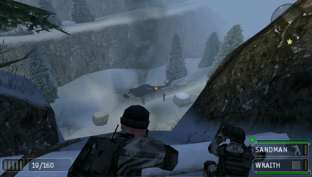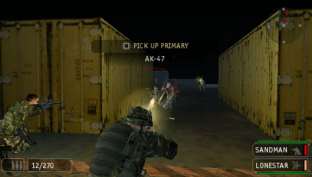The legendary US Navy Seals return to
duty in a pair of exciting releases for the PSP and PS2. SOCOM: Combined
Assault adds additional multiplayer modes, more varied maps and new moves
to the PS2 edition of the series, while SOCOM: Fire Team Bravo 2 follows
up last year's edition with deeper campaign modes, improved controls and
better visuals. What's most interesting about these games is the new
Crosstalk feature, where completing an objective in one unlocks missions
in the other. Read our review and find out why both titles offer the solid
gameplay, tactical action and great interface players have come to expect
from the series and stand as excellent sequels in these solid franchises.
As the fourth game in the successful
franchise, SOCOM: Combined Assault is another excellent installment. The
solo game offers a solidly entertaining and challenging group of
single-player missions that allows gamers to battle terrorists and other
bad guys on a variety of rugged terrain. Players have a large arsenal of
weapons to choose from including machine guns, sniper rifles, pistols
along with missile launchers, grenades and flash bombs to name just a few.
Before each mission begins, you can set up your team's weapons and items,
receive a detailed mission briefing that outlines your objectives and then
deploy into action. SOCOM: Combined Assault puts you in command of a small
group of SEALs, and you can issue orders for your team to follow, hold
position or go in with guns blazing. During combat, players can climb
behind walls, crawl through embankments and use sniper goggles to keep a
safe distance. You'll spend the majority of each campaign on foot, but you
can also use a variety of vehicles such as tanks, Jeeps and boats to move
around the battlefields faster. The game's missions themselves are divided
into different objectives, which are indicated on your HUD with code names
such as Alpha or Charlie. Once you reach these points, you will then move
onto the next area. During the missions, you'll encounter a variety of
different obstacles, with each level swarming with foes. The enemy AI is
surprisingly intelligent this time around, and the opposing forces do a
good job of hiding and taking cover, making it hard to eliminate them.
 Each
level consists of multiple objectives, and if you fail at one, you have to
start over from the beginning, so it pays to stay focused since mistakes
can be quite costly, but the missions unfold at a good pace. There's an
excellent balance of strategy and action that keeps you hooked throughout.
Combined Assault's controls and interface remain largely unchanged but
this is a good thing, since it makes issuing commands, changing weapons
and viewpoints easier for veterans. Trying to blow through each mission
and shooting everything in sight is a bad idea, since killing innocent
civilians causes you to immediately lose the mission. This isn't a
traditional shooter in that sense, since you need to learn to think on
your feet. You can also use less lethal weapons to disable foes and use
them either as collateral or to gain intelligence about the enemy. This
varied approach to missions, their different objectives and methods keeps
things more realistic and believable. The game's overall structure should
be familiar to anyone familiar with the series, and offers little that
should surprise players. Its missions progress in a similar fashion as
you'd expect them to. SOCOM: Combined Assault's levels feel a bit larger
and slightly more realistic than previous games, and most players should
find this increased space adds to the experience.
Each
level consists of multiple objectives, and if you fail at one, you have to
start over from the beginning, so it pays to stay focused since mistakes
can be quite costly, but the missions unfold at a good pace. There's an
excellent balance of strategy and action that keeps you hooked throughout.
Combined Assault's controls and interface remain largely unchanged but
this is a good thing, since it makes issuing commands, changing weapons
and viewpoints easier for veterans. Trying to blow through each mission
and shooting everything in sight is a bad idea, since killing innocent
civilians causes you to immediately lose the mission. This isn't a
traditional shooter in that sense, since you need to learn to think on
your feet. You can also use less lethal weapons to disable foes and use
them either as collateral or to gain intelligence about the enemy. This
varied approach to missions, their different objectives and methods keeps
things more realistic and believable. The game's overall structure should
be familiar to anyone familiar with the series, and offers little that
should surprise players. Its missions progress in a similar fashion as
you'd expect them to. SOCOM: Combined Assault's levels feel a bit larger
and slightly more realistic than previous games, and most players should
find this increased space adds to the experience.
Combined Assault's solo campaign is
highly-tuned, brightly-polished and solidly constructed. The game's
visuals are in-line with expectations, though not significantly better
than previous installments. This is still a good-looking PS2 title with a
variety of environments ranging from bleak mountain ranges, snowy fields
and muddy swamps. It's character models are decent, with decent animation
and some light sourcing used to make things more pleasing. Multiplayer
modes have seen the biggest changes. In addition to the maps first seen in
SOCOM 3, there are several new ones included as well. The biggest
improvement lies in the support for 4-player missions, which allows
players to finally bring the action online in the same detailed manner as
the main game. As expected, the online mode offers a number of different
play modes, most of which have been carried from previous titles. In
addition to all of this, the new Crosstalk feature allows players who own
SOCOM: FireTeam Bravo 2 to transfer data from the PSP to the PS2, which
unlocks additional missions and objectives on the PS2 edition. SOCOM:
Combine Assault lives up to the production, presentation and gameplay
standards set by previous games, adds a few new features that makes for an
entertaining title. However, the gameplay doesn't end with this release,
since, as we've mentioned, the PSP version of the game works in tandem to
create an even richer experience.
Players who found last year's PSP SOCOM
installment a bit too short and simplified will be happy to learn that
SOCOM: FireTeam Bravo 2 offers some significant improvements. The biggest
of these are the newly implemented non-linear mission progression system
that allows players to choose the order in which they complete missions.
This helps to open things up a little bit more this time around. Another
interesting twist comes in the fact that you can go back and replay
levels, where new enemies and objectives may have cropped up, enhancing
the replay value. In addition to opening up the structure, it makes for a
more realistic approach. This might seem repetitive, but over time,
players can build up your reputation among the locals. This means you'll
get co-operation instead of hostility when you deploy into an area you've
already been through. The locals will provide you with intelligence and
aid, from nearby citizens if they get through missions without hurting
civilians. Players will also find much larger battlefields, with a similar
non-linear structure implemented this time around. In addition, the
player's progress is now tracked with Command Equity points, which are
earned by completing missions. When these are earned, you can use them to
purchase additional items, such as weapons and more.
 Fire
Team Bravo 2's gameplay is largely similar to last year's installment,
with a similar set of controls and HUD display. It can be a little bit
confusing to use at times, but once you become accustomed to it, things
get much easier. An intuitive interface and controls let you command your
troops effectively. Issuing commands, ordering strikes and cover is a
simple process that allows you to concentrate on the task at hand. The
game offers a good selection with more than 16 single player levels, each
of which offers a variety of objectives to complete. Players will go
through the campaign primarily on foot, and the weapons and vehicle
selection found in Combined Assault is much more limited on the hand-held
version. The single player campaigns look fairly good by the PSP's
standards, with a wide variety of environments to engage combat in. While
it doesn't look nearly as smooth as it could, this is still a solid
performer on the handheld. PSP owners will find the game is simple and
accessible. Fire Team Bravo 2's straightforward mission structure,
commands and controls are well-suited to the PSP for the most part, though
some of the navigational menus are tricky to keep straight during the heat
of battle.
Fire
Team Bravo 2's gameplay is largely similar to last year's installment,
with a similar set of controls and HUD display. It can be a little bit
confusing to use at times, but once you become accustomed to it, things
get much easier. An intuitive interface and controls let you command your
troops effectively. Issuing commands, ordering strikes and cover is a
simple process that allows you to concentrate on the task at hand. The
game offers a good selection with more than 16 single player levels, each
of which offers a variety of objectives to complete. Players will go
through the campaign primarily on foot, and the weapons and vehicle
selection found in Combined Assault is much more limited on the hand-held
version. The single player campaigns look fairly good by the PSP's
standards, with a wide variety of environments to engage combat in. While
it doesn't look nearly as smooth as it could, this is still a solid
performer on the handheld. PSP owners will find the game is simple and
accessible. Fire Team Bravo 2's straightforward mission structure,
commands and controls are well-suited to the PSP for the most part, though
some of the navigational menus are tricky to keep straight during the heat
of battle.
Obviously, it's not as robust as the PS2
version, though there's still enough authenticity in the military tactics
and thoughtful gameplay to make this a more realistic shooting experience.
While the single-player missions are solidly constructed, Fire Team Bravo
2 really shines with its excellent multiplayer modes. Connecting with
either the Ad-Hoc or Infrastructure mode allows players to compete in an
all-out dog fight with up to 16 other players. The sheer intensity and fun
of these modes makes them quite enjoyable, and the variety of maps and
modes adds to the enjoyment and replay value. From an aesthetic
standpoint, FTB 2 feels a bit more polished and realistic than last year's
PSP game with more detailed environments, better character animation and
more elaborate voice acting that makes things feel much more coherent this
time around. It's not as rough as last year's edition, and the
improvements really make for a deeper, more satisfying gameplay
experience. Add in the Cross-Talk feature and you have a definite solid
game that should please fans with a variety of modes, solid gameplay and
challenging design. Overall, both games great on their own, but taken
together, they're definitely more than the sum of their parts, making a
purchase of both more enjoyable on an individual basis.
> Grades:
Combined Assault: B+
Fire Team Bravo 2: B

